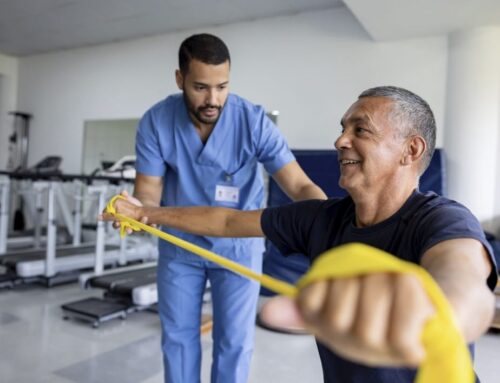The knees are the largest joints in the body. They bear our weight and absorb the shock of walking, jumping, dancing and moving. Over time, activities, injuries and disease can cause knee problems. When knee pain becomes severe and can’t be alleviated by other non-invasive treatments, it may be time for a knee replacement.
Joint replacement surgeries, like knee replacements, are among the safest and most successful treatments for chronic knee pain. Orthopedic surgeons perform hundreds of thousands of knee replacement surgeries each year. Over the past 50 years, studies have shown joint replacements effectively and reliably restore mobility and quality of life for patients with severe knee pain.
Our doctors often get the question: What is a total knee replacement? This article will explain the procedure, reasons for having it done, the recovery process and the benefits of total knee replacement surgery.
What is a total knee replacement?
The knee joint is comprised of bones, discs, ligaments, tendons and muscles. It is divided into three compartments. The medial compartment is the inside of the knee. The lateral compartment describes the outside of the knee, and the patellofemoral compartment is the kneecap joint.
Knee replacement surgery removes damaged or diseased sections of the knee and replaces them with new metal and plastic parts. Knee replacement surgeries can be either total joint replacements or partial joint replacements.
Partial knee replacements are recommended for people with degeneration only in one compartment of the knee. Total knee replacements, or total knee arthroplasties, help people who have degeneration in more than one compartment.
A total knee replacement removes damaged cartilage and small amounts of the femur (thigh bone) and tibia (shin bone), then replaces them with a high-quality metal and plastic knee prosthesis. The metal components are surgically cemented to the tibia and femur to create a new joint surface.
The underside of the kneecap that rubs against the thigh bone is also resurfaced and capped to fit the new artificial joint. The orthopedic surgeon then inserts a medical-grade plastic spacer between the metal components. This simulates knee cartilage and allows the knee joint to glide smoothly.
Before the surgery, Cary Orthopedic surgeons order diagnostic imaging, like a CT scan or MRI. They use these images of the joint to see where to make the incision. This allows the surgeon to navigate the joint precisely and prevent disrupting surrounding muscles, ligaments and tendons.
When to consider a total knee replacement
A number of indicators can help you and your doctor decide whether a partial or total knee replacement is needed and when.
Normal joints move smoothly because they are coated with cartilage that acts as a shock absorber. When knee cartilage becomes damaged by wear and tear, a knee injury or arthritis, the bones begin to rub and can grind against each other. This can cause debilitating pain and loss of range of motion.
The most common source of chronic knee pain is arthritis, specifically osteoarthritis and post-traumatic arthritis.
Based on the condition of the knee and the progression of any arthritis, orthopedic doctors often recommend other non-invasive treatments before a knee replacement. Other treatments to try before a total knee replacement include oral non-steroidal anti-inflammatories, injections and physical therapy.
When these treatments become ineffective, it is wise to have a conversation with your doctor.
The following symptoms are also good indicators that it is time to discuss a total knee replacement with your orthopedic physician:
- Severe, debilitating knee pain that limits everyday activities
- Swelling, stiffness and numbness
- Difficulty bending or straightening the leg
- Chronic knee inflammation that does not improve with rest or medication – day or night
- Difficulty walking, going up steps, getting into or out of cars, standing up from a chair or pain that significantly limits your activity
If your knee becomes hot, swollen and immobile, immediate medical attention is needed.
A knee replacement can help. Total knee replacements seek to restore mobility, reduce pain, and improve patients’ quality of life. However, they are major surgery. Patients should factor in recovery efforts and time when deciding if they want to have a total knee replacement.
What to expect during recovery
Typically, total knee replacement patients are up and walking the day of the surgery and can return home within 24 hours after surgery. Your doctor will want you to get up and move after your surgery to prevent blood clots. Moving after surgery has also been shown to help the knee to heal quickly and develop better mobility and strength.
Most knee replacement patients use a continuous passive machine (CPM) to passively and repeatedly move the knee through a specified range of motion. This prevents scar tissue buildup and relieves joint stiffness.
Most activities can be resumed six weeks after surgery, while the total healing process can take 6 to 12 months. Recovery depends on several factors, including your age, tissue health, the scope of the procedure, and how your body responds to rehabilitation.
We cannot overstate the importance of rehabilitation following a total knee replacement. Do not underestimate the power of your rehab. Patients with the best outcomes faithfully follow the directions of their physical therapists.
Physical therapy following total knee arthroscopy works to strengthen the joint, improve range of motion, decrease inflammation and develop better muscle function. It will be challenging but rewarding when you can return to the many activities you enjoy.
Benefits of a total knee replacement
There are many benefits to total knee replacements, most notably a dramatic reduction in knee pain, improved mobility and a better quality of life. A knee replacement can enable you to return to low-impact activities, provide pain-free sleep and perform daily activities without pain.
Most artificial joints last 15 to 20 years or more due to their durable, quality construction and materials. This prevents the patient from having to repeat surgery within a few years.
Total knee replacements are one of the most successful surgeries in all of medicine and one of the safest, most successful treatments for joint pain and disease.
Considering a joint replacement? Discuss it with our doctors
If you are suffering from significant pain in the hips or knees and can’t get relief, contact Cary Orthopaedics. Our fellowship-trained, board-certified orthopedic physicians perform hundreds of knee replacement surgeries every year, including revisions.
Our offices are conveniently located in the Raleigh area, and we serve patients throughout the Triangle at our state-of-the-art facilities. Contact our orthopedic knee specialists today to schedule a consultation.






